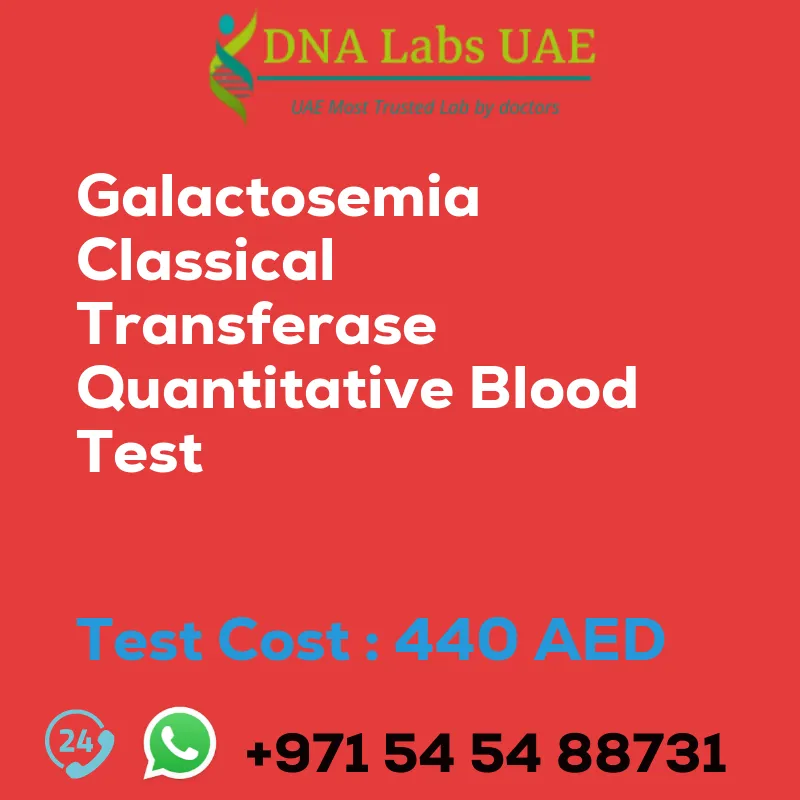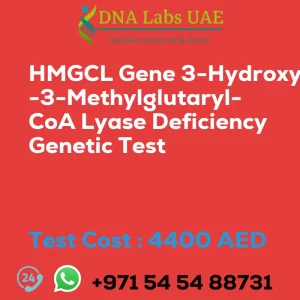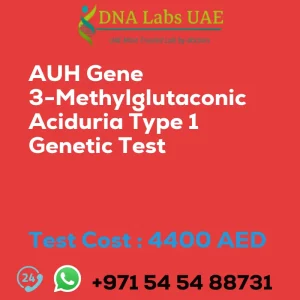GALACTOSEMIA CLASSICAL TRANSFERASE QUANTITATIVE BLOOD Test
At DNA Labs UAE, we offer the GALACTOSEMIA CLASSICAL TRANSFERASE QUANTITATIVE BLOOD test to help diagnose classical galactosemia, a rare genetic disorder that affects the body’s ability to break down galactose.
Test Details
The GALACTOSEMIA CLASSICAL TRANSFERASE QUANTITATIVE BLOOD test is a diagnostic tool used to measure the levels of transferase enzyme activity in the blood. This test specifically helps in diagnosing classical galactosemia, which is characterized by the absence or significantly reduced activity of the transferase enzyme.
Test Components and Price
Test Name: GALACTOSEMIA CLASSICAL TRANSFERASE QUANTITATIVE BLOOD Test
Components: 4 mL (2 mL min.) whole blood from 1 Green Top (Sodium Heparin) tube. Ship refrigerated. DO NOT FREEZE. Avoid sample collection for 60 days post transfusion. Clinical and drug history must accompany sample.
Price: 440.0 AED
Test Method
The GALACTOSEMIA CLASSICAL TRANSFERASE QUANTITATIVE BLOOD test is performed using an enzyme assay method. The blood sample collected from the individual is analyzed in a laboratory setting to measure the levels of transferase enzyme activity.
Test Type
The GALACTOSEMIA CLASSICAL TRANSFERASE QUANTITATIVE BLOOD test falls under the category of inborn errors of metabolism tests. It helps in identifying genetic disorders related to the body’s metabolism.
Doctor and Test Department
Doctor: Pediatrician
Test Department: GENETIC
Pre Test Information
It is important to avoid sample collection for 60 days post transfusion. Clinical and drug history must accompany the sample to ensure accurate results.
Symptoms and Diagnosis
Classical galactosemia is characterized by the accumulation of galactose and its metabolites in the body due to the absence or reduced activity of the transferase enzyme. This can lead to various symptoms and complications. Early detection and diagnosis of classical galactosemia are crucial to prevent severe complications such as liver damage, intellectual disability, and cataracts.
Treatment and Management
Once diagnosed, treatment for classical galactosemia usually involves strict dietary management, which includes avoiding foods that contain galactose. It is important to consult with a healthcare professional or genetic counselor for further information and guidance if you suspect galactosemia or have a family history of the condition.
Report Delivery
Sample Daily by 4 pm; Report 5 days
| Test Name | GALACTOSEMIA CLASSICAL TRANSFERASE QUANTITATIVE BLOOD Test |
|---|---|
| Components | |
| Price | 440.0 AED |
| Sample Condition | 4 mL (2 mL min.) whole blood from 1 Green Top (Sodium Heparin) tube. Ship refrigerated. DO NOT FREEZE. Avoid sample collection for 60 days post transfusion. Clinical and drug history must accompany sample. |
| Report Delivery | Sample Daily by 4 pm; Report 5 days |
| Method | Enzyme assay |
| Test type | Inborn errors of metabolism |
| Doctor | Pediatrician |
| Test Department: | GENETIC |
| Pre Test Information | Avoid sample collection for 60 days post transfusion. Clinical and drug history must accompany sample. |
| Test Details |
The GALACTOSEMIA CLASSICAL (TRANSFERASE) QUANTITATIVE BLOOD test is a diagnostic tool used to measure the levels of transferase enzyme activity in the blood. This test is specifically used to diagnose classical galactosemia, which is a rare genetic disorder that affects the body’s ability to break down galactose, a sugar found in milk and other dairy products. In individuals with classical galactosemia, the transferase enzyme is either completely absent or significantly reduced in activity. This leads to the accumulation of galactose and its metabolites in the body, causing various symptoms and complications. The quantitative blood test involves taking a blood sample from the individual and analyzing it in a laboratory setting. The levels of transferase enzyme activity are measured, and if the activity is significantly low or absent, it indicates a diagnosis of classical galactosemia. Early detection and diagnosis of classical galactosemia are crucial to prevent severe complications, such as liver damage, intellectual disability, and cataracts. Treatment usually involves strict dietary management, avoiding foods that contain galactose. It is important to consult with a healthcare professional or genetic counselor for further information and guidance if you suspect galactosemia or have a family history of the condition. |








